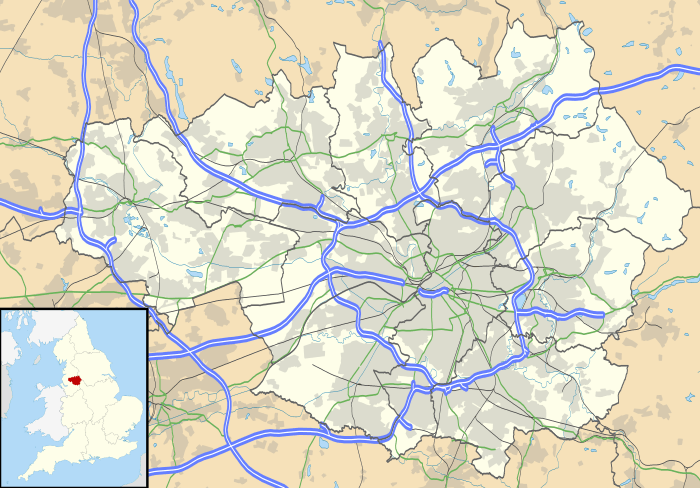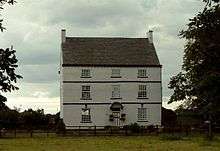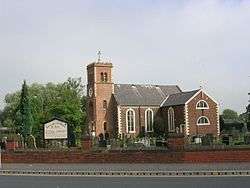Lowton
Lowton is a suburban village within the Metropolitan Borough of Wigan, in Greater Manchester, England. It is around 2 miles (3.2 km) from Leigh, 7 miles (11 km) south of Wigan and 12.0 miles (19.3 km) west of Manchester city centre. The settlement lies across the A580 East Lancashire Road.
| Lowton | |
|---|---|
.jpg) The Hare and Hounds public house, Lowton | |
 Lowton Location within Greater Manchester | |
| Population | 14,605 (2011)[1][2] |
| OS grid reference | SJ622973 |
| Metropolitan borough | |
| Metropolitan county | |
| Region | |
| Country | England |
| Sovereign state | United Kingdom |
| Post town | WARRINGTON |
| Postcode district | WA3 |
| Dialling code | 01942 01925 |
| Police | Greater Manchester |
| Fire | Greater Manchester |
| Ambulance | North West |
| UK Parliament | |
Historically a part of Lancashire, Lowton's history is closely connected with Byrom Manor, the ancestral home of the Byroms, a family which included poet John Byrom; the inventor of a system of shorthand. During the Industrial Revolution Lowton was associated with coal mining and manufacturing, given its proximity to several nearby collieries and factories.
At the 2011 census, the population of Lowton was split between two wards, Lowton East, and Golborne and Lowton West. The latter partially counted the entire population of Golborne, and partially the population of Lowton's western half, with the boundary between them roughly being at Scott Road to the north and Windsor Road to the south.[1][2] The population comes to approximately 14,605 if the appropriate parts of Golborne and Lowton West east of these streets, are added up with the population of the Lowton East ward (which was 12,617).
History
Lowton has an unclear toponymy: it is from Old English tun "farm, village" with an uncertain first element (The first element is from lhe old English for high point IE Wornoth Low near Stockport is the highest hill in the area, and Lowton is the highest point locally.) A record of the name as Liewetune in 1176 suggests Old English hleowe "lee", although this is not a certain etymology.

Lowton was one of the berewicks of the Royal Manor of Newton, later being one of the members of the Barony of Makerfield.[3] Byrom Manor, later to feature the ancestral home of the poet John Byrom and was constructed during the 18th century, is recorded as early as 1212,[3] where the family prospered for centuries. Byrom Hall at one time featured a moat.[4]
The Hare and Hounds public house, built in the 17th century, was once used as a place to hold trials of local criminals, including murders. The Lowton stocks can still be found today nearby at St Luke’s Parish Church and are Grade II listed.[5]
The former Lowton railway station was used as a resting point for the royal train.[6] Lowton had a second station – Lowton St Mary's – which closed in 1964.
Lowton had a toffee factory,[7] along with other sites of heavy industry. Many of these factories have now closed and have been replaced with light industry.
Lowton's Sandy Lane is reputedly haunted by the ghost of Joshua Rigby, a local farmer who died in 1883.[8]
Governance and politics
Between 1894 and 1974, Lowton was part of the Golborne Urban District, in the administrative county of Lancashire. In 1974 as part of the local government reorganisation enacted in the Local Government Act 1972 it became part of Greater Manchester with the boundary at Newton-le-Willows marking the edge of the new county of Merseyside.
Lowton is within the constituency of Leigh and is represented in parliament by the Conservative MP James Grundy.
Locally, the area is represented at Wigan Council by three Conservative Party members, James Grundy, Noel Houlton and Kathleen Houlton.[9]
Transport
Situated on the A580 East Lancashire Road, the village has direct access to the cities of Manchester to the east and Liverpool to the west. From this road, the M6 motorway runs north and south, and the M60 connects with the M62 across the Pennines. The nearest railway station is Newton-le-Willows on the Chester to Manchester Line and Liverpool to Manchester Line. Public transport in Lowton is co-ordinated by the Greater Manchester Passenger Transport Executive and is served by buses to Manchester, Wigan, Leigh, Newton-le-Willows and St Helens. Buses: X34 Lowton/Leigh-Manchester (First Manchester), 34 St Helens-Leigh (Arriva), 10 Leigh-Wigan (First Manchester).
Environment
To the south of Lowton is Highfield Moss, part of which has been designated a Site of Special Scientific Interest. The 52.6 acres (21.3 ha) site was designated in 1986 for its biological interest. It is predominantly notable as a mire community and it is the best example in Greater Manchester.[10]
Education
Religion
In 1635 the Puritan clergyman, Richard Mather, and his family left for New England as a result of religious intolerance.
Lowton's churches include the two Church of England churches of St Mary's and St Luke's and Lowton Independent Methodist, a member of the Independent Methodist Connexion.[12] and Lowton Community Church.[13] Lane Head Methodist church closed in 2010. The Roman Catholic church of St Catherine of Siena closed in 2011, after a health and safety inspection highlighted a problem with the electrical wiring of the 1950s building. An application was submitted to Wigan Council for permission to demolish the church and the presbytery in 2014.[14]
The churches in Lowton organise some joint activities including ecumenical services. Their charity work has included the Lowton Churches Romania Appeal, formed after the collapse of the Communist regime in Romania in 1990. It supported an orphanage in Lugoj but its remit has since expanded to include several projects in the country.
St Luke's

It is likely that the parish of Winwick (including Croft, Kenyon, Culcheth, Lowton, Newton, Earlestown, Ashton, Haydock and Wargrave) was formed shortly after the death of Oswald, a Christian prince of Northumbria, who had his palace in this district at the time.[15]
A commission under the Great Seal sat at Wigan in 1650 and considered that a chapel should be built for the townships of Lowton, Golborne and Kenyon. Some eighty years later, under the "Lowton Chapel Agreement" of 1 December 1731, twenty-seven charterers and freeholders within the township of Lowton agreed to enclose eleven acres of waste and common land on Lowton Common and on Lowton Heath, near the Locking Stoops, "for the erecting of a Chapel of Ease, and of a convenient schoolhouse", with the consent of Peter Legh, Lord of the Manor of Lowton. A date of 1732 on the church door suggests that the building was completed within a year. The Chapel was consecrated on 18 October 1733, St Luke's Day, by the Bishop of Chester. The chapel and chapel yard were built on land given by Hugh Stirrup, a yeoman of Lowton.[15]
The legal arrangements for the use of the enclosed lands, to be used for the maintenance of the minister, were not yet completed. In the interim, a sum of thirty pounds a year was guaranteed by Rev. Francis Annesley, Rector of Winwick, and Joseph Byrom of Manchester, owner of Byrom Hall. In 1734 these lands were found suitable, and were valued at £400. In 1738 the value was matched by another £400 from Queen Anne's Bounty, used for the purchase of lands and buildings, including the present rectory and the fields behind it. The land was given to Curates of Lowton in perpetuity.[15]
Although the Deed of Consecration allowed for all the regular church services and sacraments, the chapel was not yet a Parish Church and thus no burials were permitted. The parish registers were to be forwarded every year to Winwick, and no service could be held in the chapel when the Holy Sacrament was publicly administered at Winwick parish church.[15]
Today many of the chapel pews still bear metal plates showing the names of their original owners. The oldest, pew No. 1, has a plate for Edward Byrom dated 1732. Other plates bear the surnames Leigh, Kenyon, Green, Lowe, Worsley, Pierpoint, Mather and Tyler, names of some of those who were signatories to the 1731 chapel agreement of 1731, or the 1733 consecration deed.[15]
Sport and organisations
Lowton is the location for Golborne Sports and Social Club which participates in local football, hockey, bowls and cricket leagues. Other nearby sports teams include Golborne Parkside RLFC, Leigh RUFC and Leigh United FC.
Media
Lowton falls inside the circulation areas of these newspapers and websites:
- Wigan Evening Post
- Wigan Reporter
- Leigh Reporter
- Leigh Journal
- Manchester Evening News
Notable people
- Clayton Blackmore, former Wales and Manchester United footballer, used to live in Lowton.
- John Byrom, an English poet, at times lived at Byrom Hall, Slag Lane.
- Jon Clarke, a former rugby league player, grew up in Lowton.
- James Grundy, the current MP for Leigh, has lived on a farm in Lowton since birth.[16][17]
- Richard Mather, who became an American Congregational clergyman, was born in Lowton.
- Bert Worsley Farmer and Historian
- Katie White, singer with pop group The Ting Tings, was brought up on a farm in Slag Lane, Lowton.[18][19]
See also
References
Notes
- http://www.ukcensusdata.com/lowton-east-e05000855#sthash.EDkj4vwe.dpbs
- http://www.ukcensusdata.com/golborne-and-lowton-west-e05000848#sthash.9lbo3uj4.dpbs
- "British History Online". Retrieved 9 December 2006.
- "Lowton History – History and Photographs of Lowton and district (1)". Archived from the original on 22 May 2011. Retrieved 9 December 2006.
- Historic England, "Village Stocks against St. Luke's churchyard wall, Golborne (1162981)", National Heritage List for England, retrieved 13 November 2017
- "Lowton History – Transport". Archived from the original on 22 May 2011. Retrieved 9 December 2006.
- "Lowton History – History and Photographs of Lowton and district (2)". Archived from the original on 22 May 2011. Retrieved 9 December 2006.
- "The Ghost of Sandy Lane : Lowton and Golborne Local Magazine". Lowton & Golborne Local Magazine. Retrieved 22 July 2014.
- "Find Councillor". Wigan MBC. 9 May 2007.
- "Highfield Moss citation sheet" (PDF). Natural England. Retrieved 2 July 2007.
- http://www.lowtonhs.wigan.sch.uk/ Lowton High School
- "LIMC". Lowtonimchurch.co.uk. Retrieved 17 June 2015.
- Lowton, GenUKI, retrieved 13 January 2013
- "Permission sought to demolish Lowton church".
- "Parish Church of St". Stlukeschurchlowton.co.uk. Archived from the original on 3 March 2016. Retrieved 17 June 2015.
- "About James Grundy". James Grundy. Retrieved 14 June 2020.
- Grundy, James (24 April 2020). "JAMES GRUNDY - Let's retain spirit of national unity". Wigan Today. Retrieved 14 June 2020.
- DA CUZZIIEZ --Saralee + Zara-- 5 years ago (30 May 2008). "Music News " The Ting Tings debut hits No.1 on the UK charts". Undertheradar. Retrieved 28 April 2014.
- "Katie enjoys the fame game". Leigh Reporter. 16 April 2008. Retrieved 28 April 2014.
Further reading
- Worsley, Bert (1993). Pictoral History of Old Lowton. H.Worsley. ISBN 0-9511102-2-5.
External links
| Wikimedia Commons has media related to Lowton. |